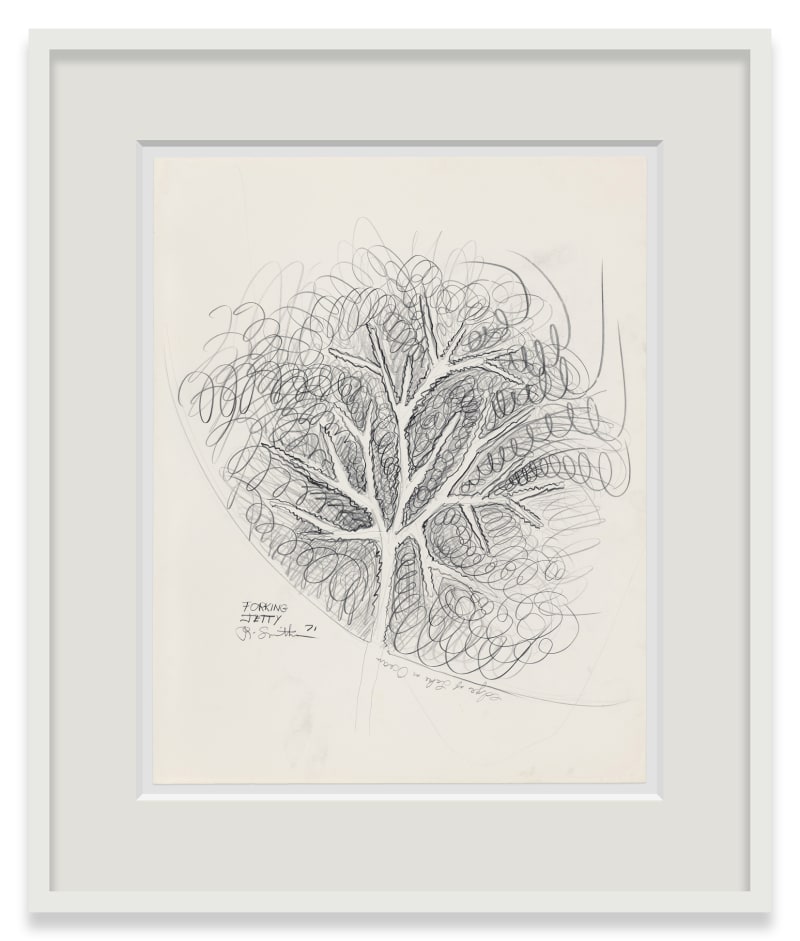"Imagine yourself in Central Park one million years ago. You would be standing on a vast ice sheet, a 4,000-mile glacial wall, as much as 2,000 feet thick. Alone on the vast glacier, you would not sense its slow crushing, scraping, ripping movement as it advanced south, leaving great masses of rock debris in its wake."
—Robert Smithson
Robert Smithson’s interests in travel, cartography, geology, architectural ruins, prehistory, philosophy, science-fiction, popular culture, and language spiral through his work. He was invested in a definition of art that was timebound and precarious, that would not claim monumental status, rather collaborate with entropy. Up until his death in 1973, Smithson demonstrated that art can be a means to explore how we might try to understand our place on the planet, with all of its complexities.
"I like landscapes that suggest prehistory. As an artist it is sort of interesting to take on the persona of a geological agent where man actually becomes part of that process rather than overcoming it."
—Robert Smithson
"(…) Light, mirror reflection, and shadow fabricate the perceptual intake of the eyes. Unreality becomes actual and solid. […] The Eliminator is a clock that doesn't keep time, but loses it."
—Robert Smithson
"Nature does not proceed in a straight line, it is rather a sprawling development. Nature is never finished."
—Robert Smithson

Frame: 26 1/8 x 31 1/2 x 1 5/8 in. (66.5 x 80.1 x 4 cm)
For Smithson, islands were speculative sites showing the constantly changing surface of our world and the limits of our knowledge. Some of his islands are locations for sculptural invention, others are sites investigating the formation of landscape.

Frame: 19 1/4 x 15 1/8 x 1 5/8 in. (48.8 x 38.3 x 4 cm)
Smithson observed that landscape and its inhabitants were always undergoing change. In 1969 he started working with temporal sculptures made from gravitational flows and pours, thinking through these alluvial ideas in drawings.
Craters and volcanoes can be found in Smithson’s early science fiction landscapes, in his sculptures, and earthworks, demonstrating his long-standing interest in geological time. The basalt rock comprising much of Spiral Jetty (1970) is, for instance, the product of extinct volcanoes, and the rings of volcanoes around Mono Lake drew him to the site.
Born in Passaic, New Jersey, Robert Smithson (January 2, 1938 – July 20, 1973), spent his formative years in New Jersey. In 1963 he married the artist Nancy Holt (1938–2014), who managed the Estate of Robert Smithson from 1973 to 2014, and who literally willed Holt/Smithson Foundation into being. Smithson is best known for his earthworks Spiral Jetty (1970), Broken Circle/Spiral Hill (1971), and Amarillo Ramp (1973). Prior to these earthworks Smithson created performative entropic land works, such as the ephemeral sculptures Asphalt Rundown (1969, Rome), Glue Pour (1969, Vancouver), Concrete Pour (1969, Chicago), and Partially Buried Woodshed (1970, Kent State), which speak poignantly to issues of time and the human condition.
Smithson's forthcoming exhibitions at Marian Goodman Gallery in London and Paris, Hypothetical Islands and Primordial Beginnings respectively, are scheduled for December 2020 - January 2021.
Smithson Artist Page | Holt/Smithson Foundation
Caption (top/header): Nancy Holt, Bob with Books: Roof of 799 Greenwich St., New York, 1971. Digitized 16mm film, color, silent; 2 min. 59 sec. © Holt/Smithson Foundation, Licensed by VAGA at ARS, New York. Distributed by Electronic Arts Intermix, New York.












